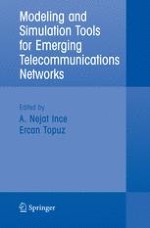2006 | OriginalPaper | Buchkapitel
Some General Terminal and Network Teletraffic Equations for Virtual Circuit Switching Systems
verfasst von : Dr. Stoyan A. Poryazov, Emiliya T. Saranova
Erschienen in: Modeling and Simulation Tools for Emerging Telecommunication Networks
Verlag: Springer US
Aktivieren Sie unsere intelligente Suche, um passende Fachinhalte oder Patente zu finden.
Wählen Sie Textabschnitte aus um mit Künstlicher Intelligenz passenden Patente zu finden. powered by
Markieren Sie Textabschnitte, um KI-gestützt weitere passende Inhalte zu finden. powered by
A virtual circuit is a connection between two users, devices, or terminals that Junctions as if it were a direct connection. Forwarding, switching, and/or routing over directly-connected circuits takes place at intermediate devices within the virtual circuit, but the details are hidden from the end points. Virtual circuits are widely used in many telecommunications and networking architectures; viz.: in wireline (PSTN, ISDN, BISDN) and wireless (GSM) telephony; in packet-switched networks at various layers (e.g., transport layer connections); in Multiprotocol Label Switched (MPLS) networks where tunnels are a type of virtual circuit; in Asynchronous Transfer Mode (ATM) networks where permanent and switched virtual circuits are fundamental components; in optical networks where wavelength routing and burst switching are abstract forms of provisioned virtual circuits; and in emerging multi-service networks where managed Ethernet virtual circuits are used to bridge legacy technologies like frame relay and ATM.
The names of the service stages, branches, and exits used herein to describe and model virtual circuits are borrowed directly from telephony and teletraffic engineering. For example, ‘blocking’ is a branch point in virtual circuit provisioning with counterparts in telephony, ATM, MPLS, Ethernet, and optical networks. The terminology is a convenient way to define a conceptual teletraffic model for these networks. Most of the service stages, branches and exits defined herein have direct counterparts in the data and/or control planes of multi-service networks.
In this paper, we define a conceptual model that is sufficiently general for a broad family of virtual circuit switching systems, and we use the model to derive expressions for traffic intensity, blocking probability, and quality of service (QoS) dimensioning of resources. The results are applicable to a number of virtual circuit switching systems and paradigms, and can be used as a basis for terminal and network teletraffic engineering tools for multi-service networks.
